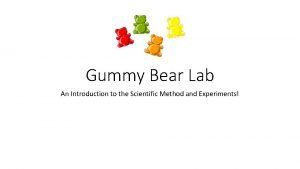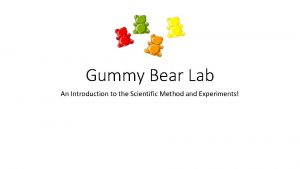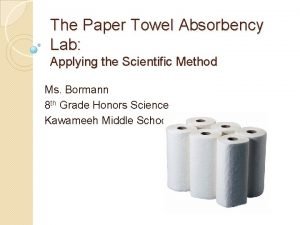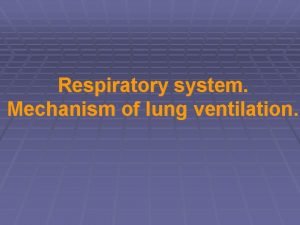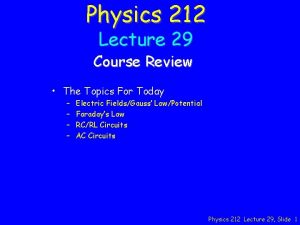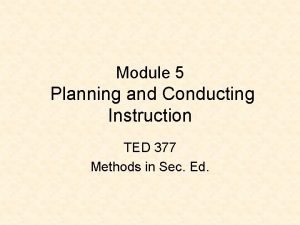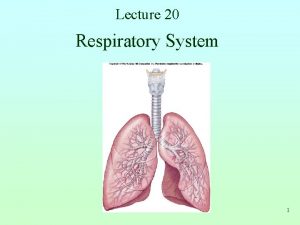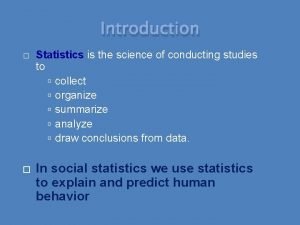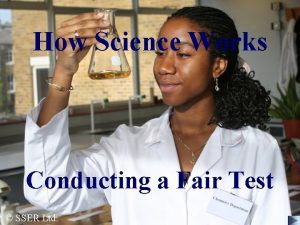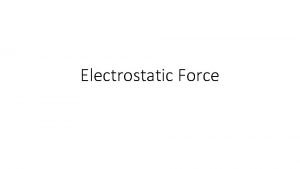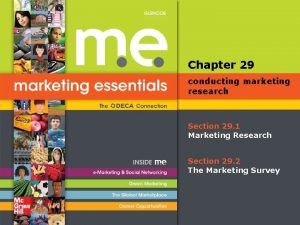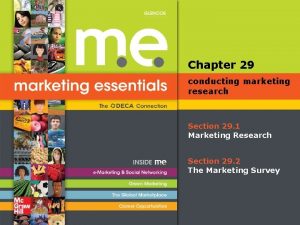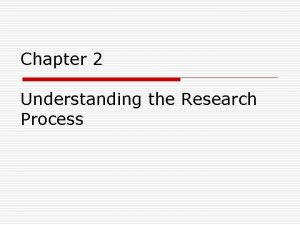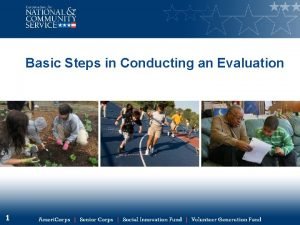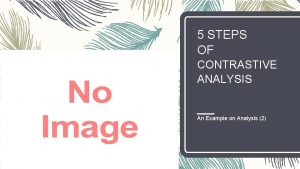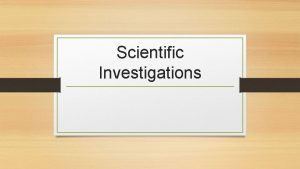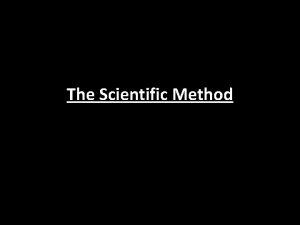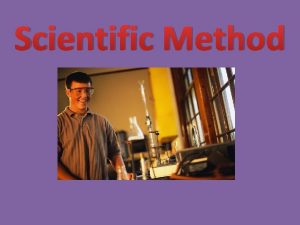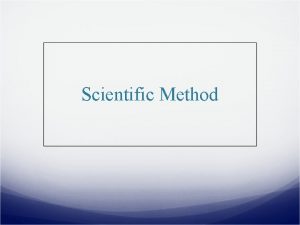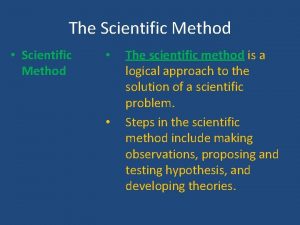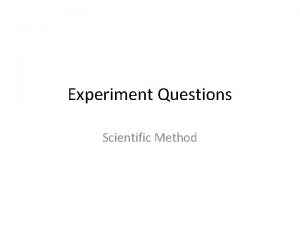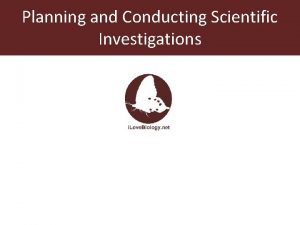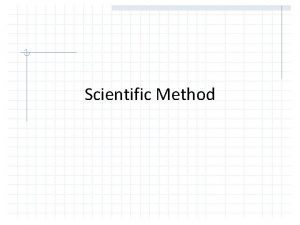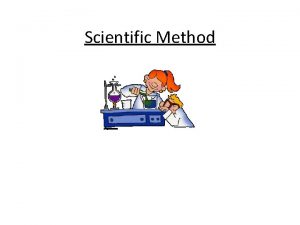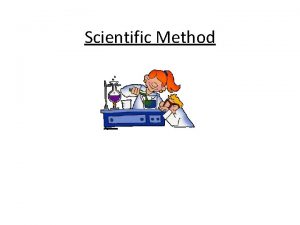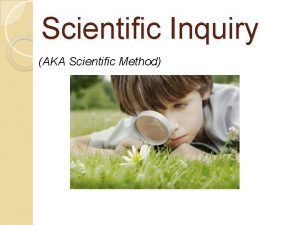Scientific Method Scientific Method When conducting a experiment




















- Slides: 20

Scientific Method

Scientific Method • When conducting a experiment, change one factor and keep everything else exactly the same. The one thing you change is called the dependent variable. All the things you keep the same are called independent variables.

Review

Scientific Method Steps • • • State the problem. Make a hypothesis. Conduct the experiment. Record/analyze data. Make a conclusion. Report findings to others so they can repeat the experiment.

Hypothesis • • An educated guess a prediction Use “If”, “then” format We predict that if we drop a ball from a higher height, then it will bounce higher. • “If” is the manipulated variable. • “Then” is the responding variable.

Observations • Observations: We use our senses to gather information about the world around us. There are two types of observations.

Qualitative • Qualitative observation: (quality) Usually made with our senses. • Color, shape, feel, taste, sound. • Olivia is wearing a blue sweater. • The lab tabletop is smooth. • The dog’s fur is shiny.

Quantitative • Quantitative observation: (quantity) How many. Will always have a number. • Based on exact measurement. • The room is 8 meters across. • Sarah is 141 -cm tall. • Sam weighs 450 Newtons.

Inferences • Inference: • A logical interpretation of an event that is based on observations and prior knowledge. • What does this mean in 6 th grade terms?

Theory defined • An explanation based on many observations during repeated experiments that is valid only if it is consistent with observations, makes predictions that can be tested, and is the simplest explanation.

• So theory of gravity, theory of electricity, the germ theory of disease, and theory of evolution are tested, accepted explanations for events that occur in nature. • Theories can really never be completely proven, only disproven. When new evidence comes along, we must modify our theory or at times even get rid of it and start over again.

Graphing • Graphs are a useful tool in science. • The visual characteristics of a graph make trends in data easy to see. • One of the most valuable uses for graphs is to "predict" data that is not measured on the graph.

Graphing Steps • • Identify the Variables Determine the range Determine the scale Number and label each axis • Plot the points • Draw the graph • Give your graph a title

Identify the Variables – Independent Variable (the thing you changed) · Goes on the X axis (horizontal) · Should be on the left side of a data table. – Dependent Variable (changes with the independent variable) · Goes on the Y axis (vertical) · Should be on the right side of a data table.

There are six steps to the Scientific Method. • • • 1. Problem 2. Information 3. Hypothesis 4. Experiment 5. Observations 6. Conclusion

Problem *This is the question that you are trying to answer or problem that you are trying to solve. *Try to narrow it down and be very specific.

Information • gather data about your question. books magazines reports experts your past experiences

Experiment • This is broken into 2 parts, materials and procedure. • Materials is a list of equipment that you will need for the experiment. • Procedure is a list of instructions that you need to follow for the experiment.

Observations • Collection of information and data from the experiment. • It may be charts, graphs, or written work. • This is WHAT HAPPENED!!!!!

Conclusion • What did you find the answer to the question was? • It is OK if it turns out that your hypothesis was not correct. You learned!!!!!
 Gummy bear density lab answer key
Gummy bear density lab answer key Gummy bear experiment scientific method
Gummy bear experiment scientific method Absorbency of paper towels experiment
Absorbency of paper towels experiment Scientific inquiry vs scientific method
Scientific inquiry vs scientific method Scientific experiment steps
Scientific experiment steps How is a scientific law different from a scientific theory?
How is a scientific law different from a scientific theory? Respiratory system zones
Respiratory system zones Conducting zone and respiratory zone
Conducting zone and respiratory zone Conducting zone lungs
Conducting zone lungs Electric potential inside non conducting sphere
Electric potential inside non conducting sphere Planning and conducting instruction in the classroom
Planning and conducting instruction in the classroom What is the conducting zone of the respiratory system
What is the conducting zone of the respiratory system The science of conducting studies to collect
The science of conducting studies to collect Conducting a fair test
Conducting a fair test Electrostatic force mean
Electrostatic force mean Electric potential and potential difference
Electric potential and potential difference Chapter 29 conducting marketing research answers
Chapter 29 conducting marketing research answers Chapter 29 conducting marketing research
Chapter 29 conducting marketing research Stages of research
Stages of research Steps in conducting evaluation
Steps in conducting evaluation Steps of contrastive analysis
Steps of contrastive analysis
